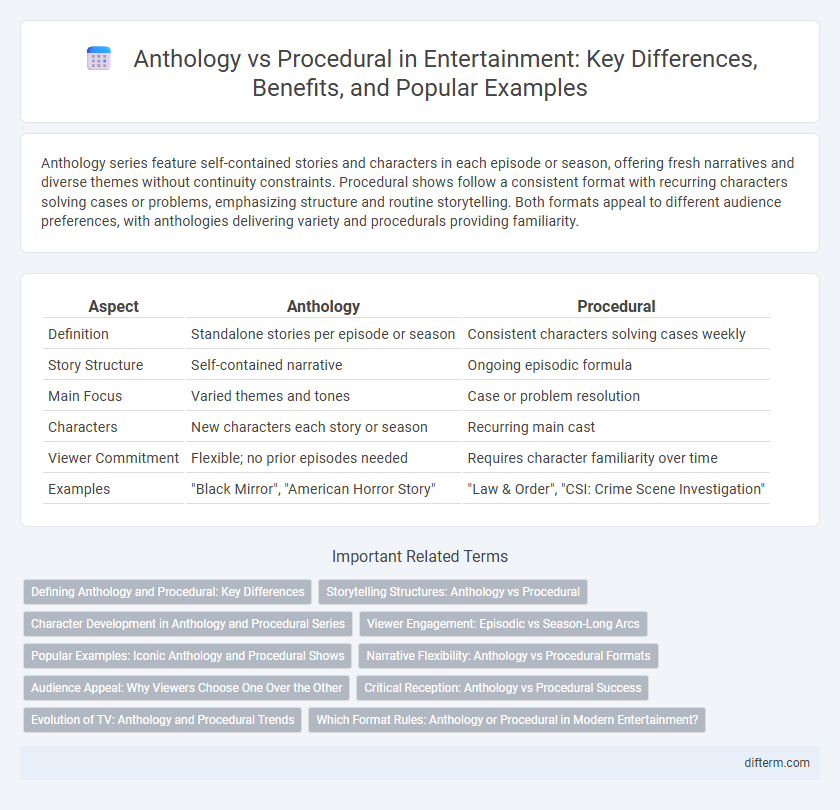Anthology series feature self-contained stories and characters in each episode or season, offering fresh narratives and diverse themes without continuity constraints. Procedural shows follow a consistent format with recurring characters solving cases or problems, emphasizing structure and routine storytelling. Both formats appeal to different audience preferences, with anthologies delivering variety and procedurals providing familiarity.
Table of Comparison
| Aspect | Anthology | Procedural |
|---|---|---|
| Definition | Standalone stories per episode or season | Consistent characters solving cases weekly |
| Story Structure | Self-contained narrative | Ongoing episodic formula |
| Main Focus | Varied themes and tones | Case or problem resolution |
| Characters | New characters each story or season | Recurring main cast |
| Viewer Commitment | Flexible; no prior episodes needed | Requires character familiarity over time |
| Examples | "Black Mirror", "American Horror Story" | "Law & Order", "CSI: Crime Scene Investigation" |
Defining Anthology and Procedural: Key Differences
Anthology series present self-contained stories or episodes with unique characters and plots, often exploring different themes or settings each season or installment. Procedural series follow a consistent structure centered around a recurring cast solving cases or tasks, emphasizing formulaic progression and episodic resolution. The key difference lies in anthology's narrative variety versus procedural's repetitive, case-driven format.
Storytelling Structures: Anthology vs Procedural
Anthology series feature standalone episodes or seasons with self-contained narratives, allowing diverse storytelling and character exploration within each installment. Procedural series rely on a consistent format with recurring characters solving cases or problems episodically, emphasizing plot-driven narratives and audience familiarity. This structural difference influences pacing, character development, and viewer engagement, shaping how stories unfold in television and streaming content.
Character Development in Anthology and Procedural Series
Anthology series prioritize deep character development by exploring unique storylines and individual character arcs in each episode or season, allowing for nuanced emotional growth and complexity. Procedural series emphasize consistent characters solving cases or problems, often limiting character development to subtle changes over time to maintain episodic self-containment. This structure enables anthology shows to offer rich, evolving personalities, whereas procedural shows focus on plot-driven narratives with steady character backgrounds.
Viewer Engagement: Episodic vs Season-Long Arcs
Anthology series captivate viewers through self-contained episodes that deliver complete narratives, encouraging casual watching without commitment to a full season. Procedural shows rely on episodic storylines with recurring characters, fostering consistent viewer engagement by balancing case-of-the-week plots with subtle character development. Season-long arcs in procedural dramas deepen emotional investment, creating tension and anticipation that sustain audience attention across episodes.
Popular Examples: Iconic Anthology and Procedural Shows
Iconic anthology shows like "Black Mirror" and "The Twilight Zone" captivate audiences with self-contained episodes exploring diverse themes and genres. Procedural dramas such as "Law & Order" and "CSI" maintain viewer engagement through recurring characters solving crimes in each episode. Both formats boast enduring popularity, with anthology series emphasizing thematic variety and procedural shows delivering consistent narrative structure.
Narrative Flexibility: Anthology vs Procedural Formats
Anthology series offer greater narrative flexibility by allowing each episode or season to explore distinct storylines and characters, enabling diverse themes and creative risks. Procedural formats follow a consistent formula with self-contained episodes, emphasizing plot-driven narratives that resolve within each installment, which limits long-term character development but appeals to viewers seeking predictable structure. The choice between anthology and procedural formats influences storytelling depth, audience engagement, and creative innovation in entertainment.
Audience Appeal: Why Viewers Choose One Over the Other
Anthology series attract viewers with their unique storytelling in each episode or season, offering fresh characters and plotlines that prevent narrative fatigue and heighten curiosity. Procedural shows draw audiences through consistent structure and familiar formulas, providing comfort and a reliable viewing experience centered on problem-solving and resolution. The appeal hinges on whether audiences prefer variety and depth in characters or predictability and closure in each installment.
Critical Reception: Anthology vs Procedural Success
Anthology series often receive critical acclaim for their unique storytelling and character depth, as seen in acclaimed shows like "Black Mirror" and "True Detective." Procedural dramas such as "Law & Order" and "CSI" gain consistent viewer engagement through formulaic plots and episodic resolutions, though they may face criticism for repetitive narratives. Critics typically praise anthologies for innovation and thematic boldness, while procedurals are lauded for reliability and long-term audience retention.
Evolution of TV: Anthology and Procedural Trends
Anthology series revolutionized TV by offering standalone episodes with unique stories and characters, fostering creative storytelling and thematic diversity. Procedural dramas gained prominence by delivering formulaic, case-based narratives that emphasize consistency and audience familiarity, driving long-term viewer engagement. Recent trends showcase hybrid models blending anthology's narrative innovation with procedural's structure, reflecting evolving audience preferences and streaming platform influence.
Which Format Rules: Anthology or Procedural in Modern Entertainment?
Anthology series like "Black Mirror" captivate audiences with self-contained, diverse stories that explore different themes each episode, while procedural shows such as "NCIS" maintain steady viewer engagement through formulaic crime-solving plots and character consistency. Streaming platforms increasingly favor anthologies for their binge-worthy variety and creative freedom, yet procedurals dominate network TV ratings due to familiar structures and loyal fanbases. The evolving entertainment landscape sees anthologies gaining critical acclaim and cultural impact, though procedurals command broader long-term commercial success.
anthology vs procedural Infographic

 difterm.com
difterm.com